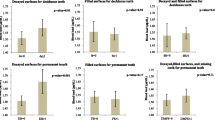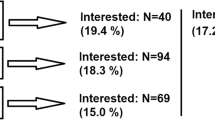Summary
Between 1982 and 1986 several surveys were carried out to determine the levels of lead and cadmium in blood, urine, and shed deciduous teeth (incisors only) of children living in rural, suburban, urban, and industrial areas of North-West Germany. Blood lead (PbB) and blood cadmium (CdB) were measured in about 4000 children. In rural, suburban and urban areas the median PbB levels vary between 5.5 and 7 μg/dl, with 98th percentiles varying between 10 and 13 μg/dl. The median CdB levels are between 0.1 and 0.2 μg/dl, with 95th percentiles between 0.3 and 0.4 μg/l. Children from urban areas have significantly higher PbB levels than children from rural and suburban areas. Regarding CdB no differences could be detected. Children living in areas around lead and zinc smelters, particularly those living very close to the smelters, have substantially increased PbB and CdB levels. Children from lead worker families also have substantially increased PbB and CdB levels. The lead levels in shed milk teeth (PbT) were determined in about 3000 children. In rural, suburban and urban areas the median PbT levels are between 2 and 3 μg/g, with 95th percentiles between 4 and 7 μg/g. Children from urban areas have significantly higher PbT levels than children from rural and suburban areas. The highest PbT levels (on a group basis) are in children from nonferrous smelter areas. The median levels of lead in urine (PbU) are between 6 and 10 μg/g creatinine, with 95th percentiles between 20 and 30 μg/g creatinine. Children from polluted areas have higher PbU levels than children from less polluted areas. The median levels of cadmium in urine (CdU) are in the order of 0.1 μg/g creatinine, with 95th percentiles being in the range of 0.5 and 1.0 μg/g creatinine. Girls have higher CdU levels than boys. There are no differences between groups of children from different areas. Children from lead worker families have higher PbU and CdU levels than otherwise comparable children. The results of the present studies indicate a further decrease of PbB in children from North-West Germany since the CEC blood lead campaigns carried out in 1979 and 1981. The decrease of lead exposure also seems to be reflected by a decrease of tooth lead levels.
Similar content being viewed by others
References
Annest JL, Pirkle JL, Makuc D, Nesse JW, Bayse DD, Kovar MG (1983) Chronological trend in blood lead levels between 1976 and 1980. New Engl J Med 308:1373–1377
Brockhaus A, Freier I, Ewers U, Jermann E, Dolgner R (1983) Levels of cadmium and lead in blood in relation to smoking, sex, occupation, and other factors in an adult population of the FRG. Int Arch Occup Environ Health 52:167–175
Brunekreef B, Noy D, Biersteker K, Boteij J (1983) Blood lead levels of Dutch city children and their relationship to lead in the environment. J Air Poll Contr Assoc 33:872–876
Brunekreef B, Veenstra SJ, Biersteker K, Boleij JS (1981) The Arnhem Lead Study I. Lead uptake by 1- to 3-year-old children living in the vicinity of a secondary lead smelter in Arnhem, The Netherlands. Environ Res 25:441–448
Buck M, Ixfeld H, Ellermann K (1982) Die Entwicklung der Immissionsbelastung in den letzten 15 Jahren in der Rhein-Ruhr-Region. Landesanstalt fur Immissionsschutz des Landes Nordrhein-Westfalen, Essen. LIS-Bericht Nr. 18
CEC (1977) Council Directive of 29 March 1977 on biological screening of the population for lead (77/312/EEC). OJ EC L105 of 28.4.1977
Claeys-Thoreau F, Bruaux P, Ducoffre G, Lafontaine A (1983) Exposure to lead of the Belgian population. Int Arch Occup Environ Health 53:109–117
Claeys-Thoreau F, Thiessen L, Bruaux P, Ducoffre G, Verduyn G (1987) Assessment and comparison of human exposure to lead between Belgium, Malta, Mexico and Sweden. Int Arch Occup Environ Health 59:31–41
Deutsche Gesellschaft für Ernährung (1984) Ernährungsbericht 1984. Frankfurt/M
Duggan MJ (1983) Contribution of lead in dust to children's blood lead. Environ Health Perspect 50:371–381
Einbrodt HJ, Rosmanith R, Primas F, Thomas F (1974) Der Blutbleispiegel bei Kindern in einem kontaminierten Industriegebiet. Naturwissenschaften 61:39–40
Elinder CG, Friberg L, Lind B, Jawaid M (1983) Lead and cadmium levels in blood samples from the general population of Sweden. Environ Res 30:233–253
Elinder CG, Friberg L, Lind B, Nilsson B, Svartengren M, Overmark I (1986) Decreased blood lead levels in residents of Stockholm for the period 1980–1984. Scand J Work Environ Health 12:112–120
Elwood P, Toothill C (1986) Further evidence of a fall in blood lead levels in Wales. J Epidemiol Commun Health 40:178–180
Englert N, Krause Ch, Thron HL, Wagner M (1986) Untersuchungen zur Bleibelastung ausgewählter Bevölkerungsgruppen in Berlin (West). Bundesgesundhbl 29:322–326
Ewers U, Brockhaus A, Genter E, Idel H, Schürmann EA (1979) Untersuchungen über den Zahnbleigehalt von Schulkindern aus zwei unterschiedlich belasteten Gebieten in Nordwestdeutschland. Int Arch Occup Environ Health 44:65–80
Ewers U, Brockhaus A, Winneke G, Freier I, Jermann E, Kramer U (1982) Lead in deciduous teeth of children living in a non-ferrous smelter area and a rural area of the FRG. Int Arch Occup Environ Health 50:139–151
Ewers U, Dolgner R, Brockhaus A, Freier I, Jermann E, Hilser W, Domisch K, Braun R (1984) Untersuchungen zur Blei-Cadmiumbelastung von Kindern und Jugendlichen in einem schwermetallbelasteten Gebiet (Stolberg). Öff Gesundh Wes 46:231–236
Ewers U, Brockhaus A, Dolgner R, Freier I, Jermann E, Bernard A, Stiller-Winkler R, Hahn R, ManojlovicN (1985) Environmental exposure to cadmium and renal function of elderly women living in cadmium-polluted areas of the Federal Republic of Germany. Int Arch Occup Environ Health 55:217–239
Ewers U, Brockhaus A, Dolgner R, Freier I, Jermann E, Hahn R, Schlipköter HW, Bernard A (1985) Cadmiumbelastung und Nierenfunktionsstörungen bei Bewohnern von Gebieten mit hoher Cadmium-Immissionsbelastung in der Bundesrepublik Deutschland. Staub Reinhalt Luft 45:560–566
Fischedick R, Hall G, Schaller KH, Valentin H, Weltle D (1983) Ergebnisse der biologischen Überwachung der Bevölkerung im Freistaat Bayern auf eine Gefährdung durch Blei. Arbeitsmed Sozialmed Praventivmed 18:39–43
Flanagan PR, McLellan JS, Haist J, Cherian GM, Chamberlain MJ, Valberg LS (1978) Increased dietary cadmium absorption in mice and human subjects with iron deficiency. Gastroenterol 74:841–846
Hahn R, Ewers U, Jermann E, Freier I, Brockhaus A, Schlipköter HW (1987) Cadmium in kidney cortex of inhabitants of North-West Germany: its relationship to age, sex, smoking and environmental pollution by cadmium. Int Arch Occup Environ Health 59:165–176
Hinton D, Coope PA, Malpress WA, Janus ED (1986) Trends in blood lead levels in Christchurch (NZ) and environs 1978–85. J Epidemiol Commun Health 40:244–248
Huel G, Boudene C, Jouan M, Lazar P (1986) Assessment of exposure to lead of the general population in the French community through biological monitoring. Int Arch Occup Environ Health 58:131–139
Jessen H, Kruse H, Piechotowski I (1984) Cadmiumkonzentrationen im Blut von Stadt- und Inselbewohnern in Schleswig-Holstein. Int Arch Occup Environ Health 54:45–54
Kowal EN, Zirkes M (1983) Urinary cadmium and β2-microglobulin: normal values and concentration adjustment. J Toxicol Environ Health 11:607–624
MAGS (= Ministerium fur Arbeit, Gesundheit und Soziales der Landes NW) (1975) Umweltprobleme durch Schwermetalle im Raum Stolberg. Düsseldorf
MAGS (1977) Luftreinhalteplan Ruhrgebiet West 1978–1982. Düsseldorf
MAGS (1978) Luftreinhalteplan Ruhrgebiet Ost 1979–1983. Düsseldorf
MAGS (1983) Umweltprobleme durch Schwermetalle im Raum Stolberg 1983. Düsseldorf
MAGS (1985) Luftreinhalteplan Ruhrgebiet West, 1. Fortschreibung 1984–1988. Düsseldorf
MURL (1986) Luftreinhalteplan Ruhrgebiet Ost, 1. Fortschreibung 1986–1990. Düsseldorf
Morton DE, Saah AJ, Silberg STI, Owens WI, Roberts MA, Saah MD (1982) Lead absorption in children of employees in a lead-related industry. Am J Epidemiol 115:549–555
Myslak ZW, Bolt HM (1987) Ökologische Bleibelastung und „normale” Blut-Bleiwerte der Bevölkerung: derzeitiger Sachstand. Zbl Arbeitsmed 37:2–8
Pocock SJ, Ashby D, Smith MA (1987) Lead exposure and children's intellectual performance. Int J Epidemiol 16:57–67
Quinn MJ, Delves HT (1985) UK blood lead monitoring programme: results for 1984. In: Int Conf Heavy Metals in the Environment, Athens, September 1985, Vol 1, pp 306-309. CEP Consultants Edinburgh
Quinn MJ (1985) Factors affecting blood lead concentrations in the UK: results of the EEC blood lead surveys 1979–1981. Int J Epidemiol 14:420–431
Rabinowitz M, Leviton A, Needleman H, Bellinger D, Waternaux Ch (1985) Environmental correlates of infant blood lead levels in Boston. Environ Res 38:96–107
Radermacher L, Prinz B, Rudolph H (1986) Bericht über die Ergebnisse der im Lande Nordrhein-Westfalen in der Zeit von Januar bis Dezember 1985 durchgeführten Staub- und Schwermetallniederschlagsmessungen. Schriftenreihe der Landesanstalt für Immissionsschutz des Landes NRW, 64:7–69
Roels HA, Buchet JP, Lauwerys RR, Bruaux P, ClaeysThoreau F, Lafontaine A, Verduyn G (1980) Exposure to lead by the oral and the pulmonary routes of children living in the vicinity of a primary lead smelter. Environ Res 22:81–94
Rosmanith J, Einbrodt HJ, Gordon T (1975a) Beziehungen zwischen Blei- und Zinkniederschlägen und den Schwermetallgehalten (Pb, Zn, Cd) im Blut, Urin und in den Haaren bei Kindern. Zbl Bakt Hyg I. AN Orig B 161:126–136
Rosmanith J, Schröder A, Einbrodt HJ, Ehm W (1975b) Untersuchungen an Kindern aus einem mit Blei und Zink belasteten Industriegebiet. Umwelthygiene 26:266–271
Schaller KH, Schneider L, Hall G, Valentin H (1984) Cadmium-Gehalt im Vollblut bei Bewohnern verschiedener Regionen des Freistaates Bayern. Zbl Bakt Hyg I. Abt Orig B 178:446–463
Stoeppler M, Brandt K, Rains TC (1978) Rapid method for the automated determination of lead in whole blood by electrothermal atomic absorption spectrophotometry. Analyst 103:714–722
Thron HL, Biesewig G (1984) Innere und äußere Bleibelastung bei Schwangeren und Neugeborenen in der Region Nordenham. Schr-Reihe Verein WaBoLu 59:231–252
Wagner HM, Krause C (1984) Ergebnisse der EG-Blutbleistudie in der Bundesrepublik Deutschland. In: Gesellschaft zur Förderung der Lufthygiene und Silikoseforschung e.V. (Hrsg) Luftverunreinigung — Wirkung auf den Menschen-Wirkungskataster, pp 47–66. Umwelthygiene [Suppl 1], Düsseldorf
Watanabe T, Koizumi A, Fujita H, Kumai M, Ikeda M (1983) Cadmium levels in the blood of inhabitants in non-polluted areas in Japan with special reference to aging and smoking. Environ Res 31:472–483
Winneke G, Beginn U, Ewert T, Havestadt C, Kraemer U, Krause C, Thron HL, Wagner HM (1985) Comparing the effects of perinatal and later childhood lead exposure on neuropsychological outcome. Environ Res 38:155–167
Zielhuis RL, Castilho del P, Herber RFM, Wibowo AAE, Salle HJA (1979) Concentrations of lead and other metals in blood of two and three year-old children living near a secondary smelter. Int Arch Occup Environ Health 42:231–239
Author information
Authors and Affiliations
Additional information
The studies presented in this communication were supported by the Ministry of Work, Health and Social Affairs and the Ministry of Environment and Agriculture of Nordrhein-West-falen, FRG
Rights and permissions
About this article
Cite this article
Brockhaus, A., Collet, W., Dolgner, R. et al. Exposure to lead and cadmium of children living in different areas of North-West Germany: results of biological monitoring studies 1982–1986. Int Arch Occup Environ Health 60, 211–222 (1988). https://doi.org/10.1007/BF00378699
Received:
Accepted:
Issue Date:
DOI: https://doi.org/10.1007/BF00378699




